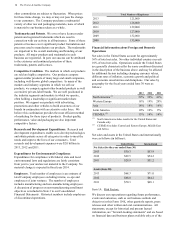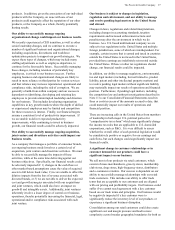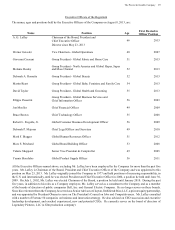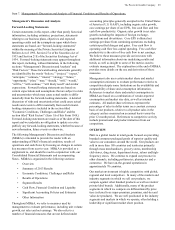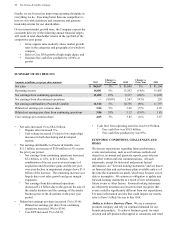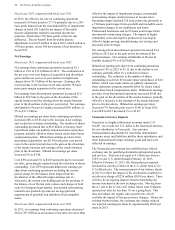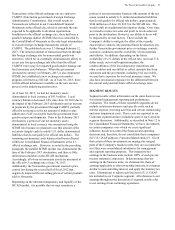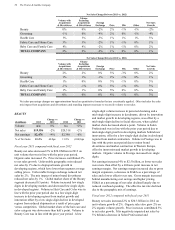Proctor and Gamble 2013 Annual Report Download - page 25
Download and view the complete annual report
Please find page 25 of the 2013 Proctor and Gamble annual report below. You can navigate through the pages in the report by either clicking on the pages listed below, or by using the keyword search tool below to find specific information within the annual report.
The Procter & Gamble Company 23
Item 7. Management's Discussion and Analysis of Financial Condition and Results of Operations.
Management's Discussion and Analysis
Forward-Looking Statements
Certain statements in this report, other than purely historical
information, including estimates, projections, statements
relating to our business plans, objectives and expected
operating results and the assumptions upon which those
statements are based, are “forward-looking statements”
within the meaning of the Private Securities Litigation
Reform Act of 1995, Section 27A of the Securities Act of
1933 and Section 21E of the Securities Exchange Act of
1934. Forward-looking statements may appear throughout
this report, including, without limitation, in the following
sections: “Management's Discussion and Analysis” and
“Risk Factors.” These forward-looking statements generally
are identified by the words “believe,” “project,” “expect,”
“anticipate,” “estimate,” “intend,” “strategy,” “future,”
“opportunity,” “plan,” “may,” “should,” “will,” “would,”
“will be,” “will continue,” “will likely result” and similar
expressions. Forward-looking statements are based on
current expectations and assumptions that are subject to risks
and uncertainties which may cause actual results to differ
materially from the forward-looking statements. A detailed
discussion of risks and uncertainties that could cause actual
results and events to differ materially from such forward-
looking statements is included in the section titled
"Economic Conditions, Challenges and Risks" and the
section titled “Risk Factors” (Item 1A of this Form 10-K).
Forward-looking statements are made as of the date of this
report and we undertake no obligation to update or revise
publicly any forward-looking statements, whether because of
new information, future events or otherwise.
The following Management's Discussion and Analysis
(MD&A) is intended to provide the reader with an
understanding of P&G's financial condition, results of
operations and cash flows by focusing on changes in certain
key measures from year to year. MD&A is provided as a
supplement to, and should be read in conjunction with, our
Consolidated Financial Statements and accompanying
Notes. MD&A is organized in the following sections:
• Overview
• Summary of 2013 Results
• Economic Conditions, Challenges and Risks
• Results of Operations
• Segment Results
• Cash Flow, Financial Condition and Liquidity
• Significant Accounting Policies and Estimates
• Other Information
Throughout MD&A, we refer to measures used by
management to evaluate performance, including unit volume
growth, net sales and net earnings. We also refer to a
number of financial measures that are not defined under
accounting principles generally accepted in the United States
of America (U.S. GAAP), including organic sales growth,
core earnings per share (Core EPS), free cash flow and free
cash flow productivity. Organic sales growth is net sales
growth excluding the impacts of foreign exchange,
acquisitions and divestitures. Core EPS is diluted net
earnings per share from continuing operations excluding
certain specified charges and gains. Free cash flow is
operating cash flow less capital spending. Free cash flow
productivity is the ratio of free cash flow to net earnings.
We believe these measures provide our investors with
additional information about our underlying results and
trends, as well as insight to some of the metrics used to
evaluate management. The explanation at the end of MD&A
provides more details on the use and derivation of these
measures.
Management also uses certain market share and market
consumption estimates to evaluate performance relative to
competition despite some limitations on the availability and
comparability of share and consumption information.
References to market share and market consumption in
MD&A are based on a combination of vendor-reported
consumption and market size data, as well as internal
estimates. All market share references represent the
percentage of sales in dollar terms on a constant currency
basis of our products, relative to all product sales in the
category and are measured on an annual basis versus the
prior 12 month period. References to competitive activity
include promotional and product initiatives from our
competitors.
OVERVIEW
P&G is a global leader in retail goods focused on providing
branded consumer packaged goods of superior quality and
value to our consumers around the world. Our products are
sold in more than 180 countries and territories primarily
through mass merchandisers, grocery stores, membership
club stores, drug stores, department stores, salons and high-
frequency stores. We continue to expand our presence in
other channels, including perfumeries, pharmacies and e-
commerce. We have on-the-ground operations in
approximately 70 countries.
Our market environment is highly competitive with global,
regional and local competitors. In many of the markets and
industry segments in which we sell our products, we
compete against other branded products as well as retailers'
private-label brands. Additionally, many of the product
segments in which we compete are differentiated by price
tiers (referred to as super-premium, premium, mid-tier and
value-tier products). We are well positioned in the industry
segments and markets in which we operate, often holding a
leadership or significant market share position.



